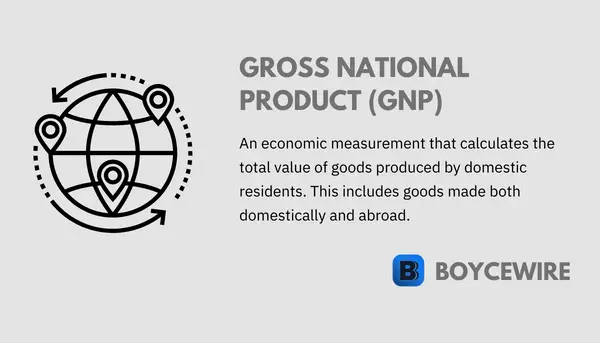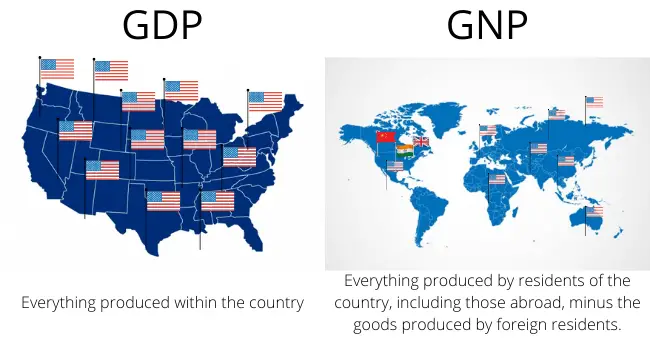Table of Contents ![]()
GNP: Definition, Formula, How to Calculate & Example

What is Gross National Product
Gross National Product (GNP) refers to the total value of goods and services that are solely produced by domestic residents. It calculates the GDP of the country, plus any income that domestic residents receive on investments abroad, but minus any income foreign residents receive on domestic investments.
To explain, we can look at GNP as what the people of the nation produce not only domestically, but also abroad. For example, Ford, an American company, manufactures and sells its motor vehicles throughout Europe. In 2019, Ford sold close to 1 million motor vehicles. Although these vehicles are made in Ford’s European factories, they fall under US GNP figures. This is because it is an American company, earning an income that is being diverted back to America.
We can also think of the measurement in terms of citizenship. Those people who are American, but operate and earn an income from abroad, are counted within GNP. The name ‘Gross National Product’ derives from the fact that the product spans national borders and across the world. So wherever Americans are producing goods, it is included within GNP for the United States.
Equally, when other citizens such as those from India and working in the USA, that income is not included with the US’ GNP figure. This is because that income is generated by Indian citizens and is therefore part of the GNP figure for India.
Key Points
- Gross National Product (GNP) refers to a nation’s economic output that is specifically produced by its citizens.
- It covers income that residents receive from abroad, but excludes income that citizens from overseas receive from domestic investments.
- GNP and GDP usually differ from each other slightly. However, a large difference between GNP and GDP may suggest many citizens are working or deriving income from abroad, meaning the nation is very integrated with the global economy.
GNP vs GDP
It is easy to confuse GNP and GDP because it derives from GDP. However, there is a slight difference between the two. GNP only factors in the income that is earned by a nations citizens. For example, if an American company earns $10 million in China – that is seen as part of American GNP.
At the same time, if a Chinese company earns $20 million in the US, that is taken away from its GNP. This is because it is not a product that is produced by an American company or citizens.
We can look at GNP as what the nation’s citizens and companies produce. We can look at GDP as the economic output produced within the nation’s borders. So the $20 million that the Chinese company earns in the US is considered within GDP. This is because it is produced within the border, whilst GNP refers to a product that is produced by the citizen of a nation.
When US companies earn more abroad than foreign companies earn in the US, the United States’ GNP will be higher than GDP. This is because its domestic companies are earning more than international firms are earning in the US.

Source:Travel vector created by freepik – www.freepik.com
GNP Formula

That stands for GNP = Consumption + Investment + Government + X (net exports) + Z (net income earned by domestic residents from overseas investments minus net income earned by foreign residents from domestic investments).
It uses the same formula as GDP. However, it also includes the net income earned by domestic residents. For example, US businesses may earn $2 billion of their income from across the globe. By comparison, other businesses from around the global may earn $1.5 billion from the US. This would then provide a positive net income of $0.5 billion, which would add on to the nations GDP.
Examples of GNP
Apple sells its products across the world, ranging from Nigeria and Kenya in Africa, to Australia and Thailand in Asia Pacific. As the company is based in the US, its revenues across the world are counted within GNP. This is because the revenues go back to the US’. Even though the products are made and sold abroad, the money returns to the US and therefore counts as GNP. By contrast, GDP will consider only the production and sales within the country.
We also have negative transfers. This is where products are sold by foreign citizens, so the revenue goes abroad. For example, Volkswagen, a German company, sells hundreds of thousands of motor vehicles in the US each year. It manufactures in the US, and sells in the US. However, those revenues come back to Germany and are therefore considered within the calculation. Whilst it increases the GNP in Germany, it decreases that of the US.
Limitations of GNP

1. Exchange Rate
GNP calculates the value of goods sold abroad by domestic firms and uses the exchange rate to convert that value into local currency. So when Apple sells 100 iPhones in Europe, this may be the equivalent of €70,000. However, that needs to be converted back into US dollars so that it is comparable to other sales.
In turn, the exchange rate can fluctuate, causing issues with GNP calculations which can change dramatically year on year. On solution is to use Purchasing Power Parity (PPP), which would allow for differences in prices of local goods. However, whilst PPP would be a better indicator, its accuracy is questionable and its frequency limited.
2. Cannot tell if Economy is Growing
GNP works out the total value of goods produced and sold by domestic companies and individuals, including those abroad. This is not an accurate measurement because global markets are so integrated that each nation will derive a significant part of its income from abroad.
If GNP is growing, it may be showing an increasing income from abroad, but doesn’t show how well the domestic economy is. For example, GNP could be growing rapidly, but unemployment could be increasing. It isn’t a good indicator to policymakers of the overall health of the economy – which is why the US switched to GDP as its official measure in 1991.
3. GNP Inflated due to Expats
Some nations, particularly poorer nations, have a high outflow of skilled workers from their countries. Often, residents from Eastern European countries such as Albania, Hungary, and Poland, will emigrate to Western European countries such as France and the UK. The income they earn from those countries is then sent home, thereby inflating GNP figures.
Countries that have a high number of expats will also likely see an inflated figure – making it a largely unreliable measurement of a nation’s economic output. However, such countries often attract a large amount of foreign direct investment (FDI) due to cheaper labour rates. Companies such as Ford and Toyota may place their factories and sell goods their goods – with the income being diverted abroad, thereby nullifying part of the income from expats.
4. GNP Deflated due to Foreign Direct Investment
When foreign firms invest in another nation, it can lead to a net outflow of GNP. For example, a big firm such as Walmart may invest in the Indian market. It sells goods and services there but sends the profits back to the US. This boosts the US figure, whilst draining that of India.
This may be offset by foreign investment by Indian companies abroad. However, in developing nations such as India, this is not always the case. In such nations, there is a large difference between the investment received and the investment sent abroad. In turn, it may lead to a deflating effect on GNP as foreign investors take their profits and send them back abroad.
FAQs
GDP calculates the amount of economic output that a country produces within its borders. By contrast, GNP is the economic output a countries citizens produce inside and outside of the country.
GNP stands for Gross National Product. It measures the total economic output produced by residents of the country that produce an output both domestically, but also the income residents receive from abroad.
GNP is calculated by using the formula: Consumption + Investment + Government + X (net exports) + Z (net income earned by domestic residents from overseas investments minus net income earned by foreign residents from domestic investments).
About Paul
Paul Boyce is an economics editor with over 10 years experience in the industry. Currently working as a consultant within the financial services sector, Paul is the CEO and chief editor of BoyceWire. He has written publications for FEE, the Mises Institute, and many others.

Further Reading
 GNP: Definition, Formula, How to Calculate & Example - Gross National Product (GNP) refers to the total value of goods and services where the means of production is owned…
GNP: Definition, Formula, How to Calculate & Example - Gross National Product (GNP) refers to the total value of goods and services where the means of production is owned…  Gini Coefficient: Definition, How to Calculate & Formula - Simply put, the Gini coefficient is a statistical measure used to calculate inequality within a nation.
Gini Coefficient: Definition, How to Calculate & Formula - Simply put, the Gini coefficient is a statistical measure used to calculate inequality within a nation. 

